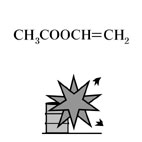| Case Name |
Explosion and fire caused due to simultaneous addition of the whole quantity of additives at a stretch on redistilling vinyl acetate monomer |
| Pictograph |

|
| Date |
March 14, 1954 |
| Place |
Kanose, Niigata, Japan |
| Location |
Chemical factory |
| Overview |
An explosion occurred at the redistillation column for crude vinyl acetate. The raw materials and the total quantities of benzoyl peroxide were charged into the column at the same time, and the explosion occurred. The benzoyl peroxide should have been charged with a smaller amount by dividing into many times. The process design at that time differs from that at present, and cooling capacity of the condenser was insufficient in an emergency. |
| Incident |
An explosion occurred at a redistillation column that refined a crude vinyl acetate monomer. Simultaneously, raw materials and benzoyl peroxide as additives were charged. With a rapid temperature rise, the vapor spouted. A cooling operation was carried out, but not in time, and a fire occurred. |
| Processing |
Manufacture |
| Individual Process |
Distillation |
| Process Flow |
Fig2.Unit process flow
|
| Substance |
Vinyl acetate, Fig3 |
| Benzoyl peroxide, Fig4 |
| Type of Accident |
Leakage, explosion, Fire |
| Sequence |
570 kg of raw materials, 570 g of benzoyl peroxide (0.1%) were charged into the redistillation column. At that time, temperature rose to 73 °C. Although hydroquinone should be charged after 20 minutes, the charge of hydroquinone could not conduct because the vapor spouted from the charge valve. Cooling water was sent to the jacket in a hurry. However, the spouting of the vapor did not stop, and the redistilling column exploded with a loud sound, and a fire occurred in the factory. |
| Cause |
Originally, the charge of benzoyl peroxide should be divided into many times with small amount of each. As it was charged at one time, a polymerization reaction occurred. Moreover, it is considered that the reaction was accelerated by not being able to add hydroquinone as an inhibitor. Cooling capacity of the condenser in an emergency was also insufficient. |
| Knowledge Comment |
The design of cooling capacity for a batch process is difficult. The cooling capacity must correspond to the maximum cooling load, for instance, at the start-up of operation. The most abnormal conditions should be assumed. |
| Background |
1. There was a failure in the operation.
2. There was a lack of knowledge about the danger of benzoyl peroxide and the role of hydroquinone which suppresses the reaction. Insufficient education was presumed.
3. Cooling capacity was only for the demands of stable operation. Work instructions and the way of operation might have been insufficient because there was no consciousness of an emergency case.
4. As this accident is too old, it is uncertain whether the operation and the mechanical level was average or not in the general level at that time. |
| Incidental Discussion |
It was designed in 1954, and the approach to cooling capacity might have seemed to be sufficient for stable operation. |
| Reason for Adding to DB |
Example of accident caused due to slipshod operation |
| Scenario |
| Primary Scenario
|
Organizational Problems, Inflexible Management Structure, Insufficient Education/Training, Misjudgment, Misunderstanding, Mis-Convincement, Planning and Design, Poor Planning, Poor Design, Regular Operation, Erroneous Operation, Mistake Opertion, Bad Event, Chemical Phenomenon, Abnormal Reaction, Secondary Damage, External Damage, Explosion, Bodily Harm, Injury, 6 person injured, Loss to Organization, Economic Loss, Direct Monetary Damage 100 million yen
|
|
| Sources |
Masamitsu Tamura. Masahide Wakakura. Explosion and fire of vinyl acetate monomer. Reaction danger.-Accident case and analysis - p.141(1995).
|
| Number of Injuries |
6 |
| Physical Damage |
A factory and a product warehouse were totally lost by fire. |
| Financial Cost |
¥ 100 million. (Property insurance rate calculation association) |
| Multimedia Files |
Fig3.Chemical formula
|
|
Fig4.Chemical formula
|
| Field |
Chemicals and Plants
|
| Author |
ARAI, Mitsuru (Environmental Science Center, The University of Tokyo)
TAMURA, Masamitsu (Center for Risk Management and Safety Sciences, Yokohama National University)
|
|